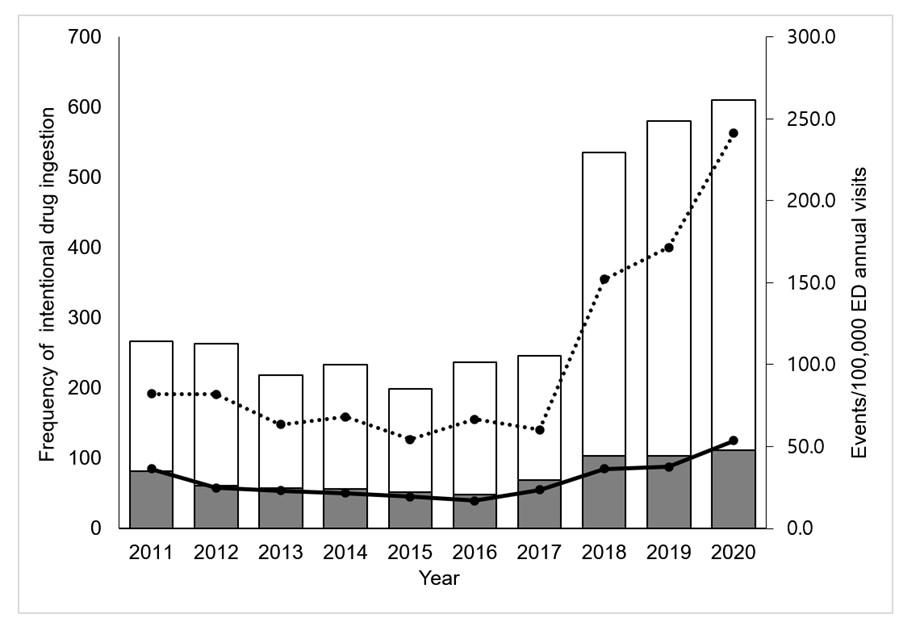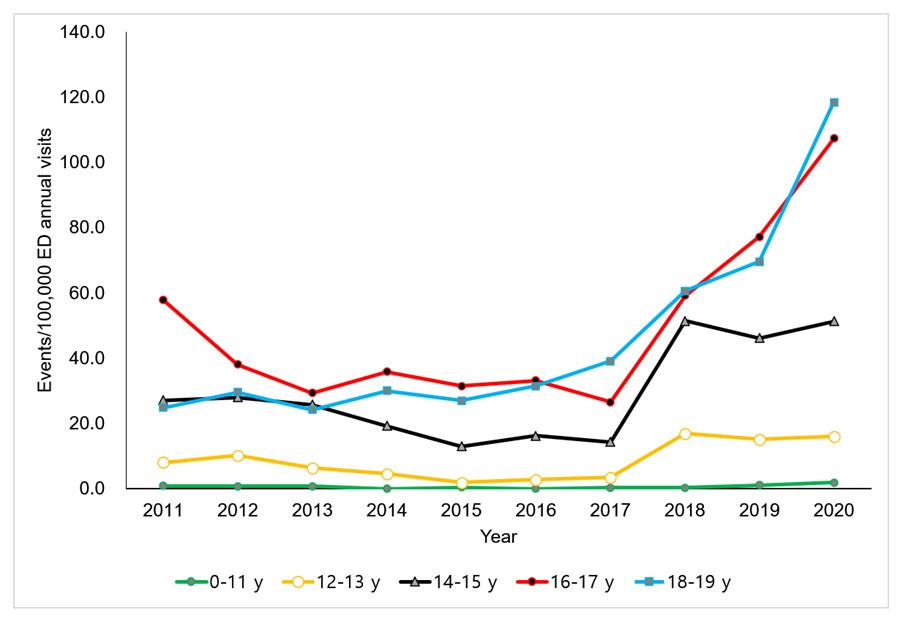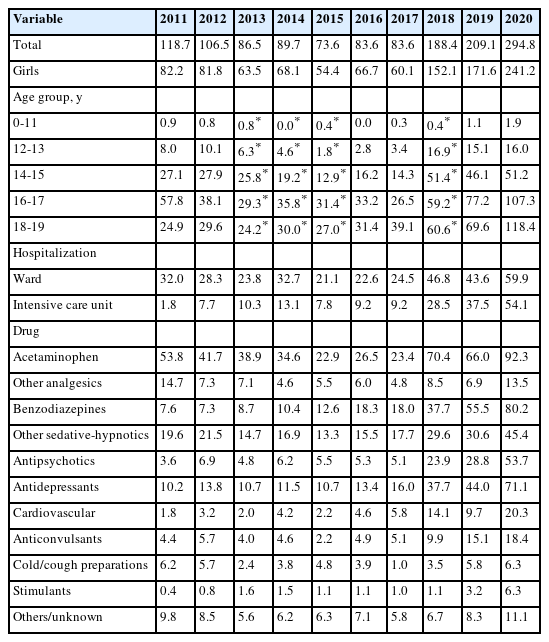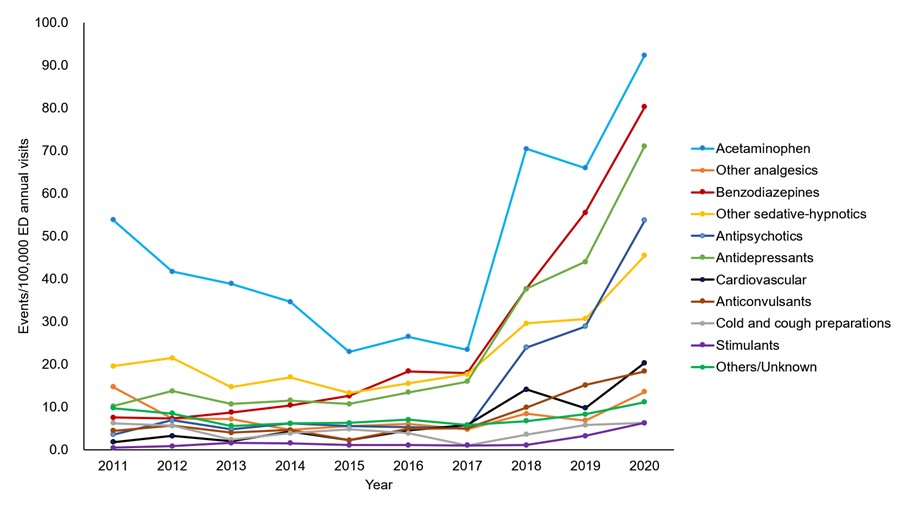2011-2020년 소아청소년의 의도적 약물중독 경향 분석
Analysis of 2011-2020 intentional drug poisoning in children and adolescents
Article information
Trans Abstract
Purpose
We aimed to investigate the changing trends in intentional drug poisoning among pediatric and adolescent patients over the past 10 years.
Methods
A retrospective study was conducted on patients younger than 20 years who visited an academic hospital emergency department (ED) in Incheon, Korea, from January 2011 through December 2020. The study focused on patients who responded with “self-harm or suicide” in the ED-based Injury In-depth Surveillance, and whose injury mechanism was drug poisoning. Exclusion criteria were unintentional injuries and the ingestion of substances other than drugs. To describe the trend over the decade, we used the number of events/100,000 ED annual visits of the database.
Results
A total of 3,388 cases with a median age of 17 years (interquartile range, 15-18 years) were included. The most frequently ingested drugs were acetaminophen (27.8%), followed by benzodiazepines (15.2%), antidepressants (14.1%), other sedatives and hypnotics (13.4%), and antipsychotics (8.3%). As for the events/100,000 ED annual visits, benzodiazepines showed the biggest increase, from 7.6 to 80.2 cases. Similarly, antidepressants increased from 10.2 to 71.1 cases, and antipsychotics from 3.6 to 53.7 cases.
Conclusion
Intentional drug poisoning has increased over the past 10 years, particularly in benzodiazepines, antidepressants, and antipsychotics. It is advisable to establish injury prevention strategies according to patients’ characteristics and ingested drugs.
서론
세계보건기구에 따르면 연간 20세 미만 약 45,000명이 급성 중독으로 사망한다(1). 한국에서 연간 같은 나이대 환자 371-2,872명이 약물중독 관련 진단으로 의료기관을 방문했다(2). 한국 청소년 사망원인 1위인 자살은 2019년 기준 100,000명당 24.6명이며(3), 시도 방법 중 급성 중독이 49.2%였다(4). 청소년은 손목 자상, 음독 등 덜 위험한 자살 시도를 반복하는데, 시도 횟수가 늘수록 반복 위험이 커지고 사망으로 이어질 수 있다(5,6). 약물중독은 주로 우발적으로, 쉽게 구할 수 있는 약을 섭취함으로써 발생하는 경향이 있다(7). 의도적 약 섭취 관련 연구를 보면, salicylate 섭취 감소, acetaminophen 섭취로 인한 입원 증가, 일반의약품, 처방 진정제, 항우울제, 항정신병약 섭취 증가 등을 알 수 있다(8-11). 또한 지역 또는 국가 단위로 청소년의 의도적 약물중독 양상에 관한 연구가 많이 있으나(11-17), 한국 연구는 부족한 실정이다.
소아⸱청소년의 의도적 약물중독 환자의 특성 및 중독 약에 관한 최근 경향을 아는 것은 급성 중독 환자를 자주 접하고 처치하는 응급실 의료진에게 중요하고, 급성 약물중독 예방 전략을 수립하는 데 도움이 된다. 본 저자는 한국 23개 병원의 응급실 손상환자 심층조사 자료를 활용하여, 지난 10년간 소아⸱청소년의 의도적 약물중독의 변화 경향을 알아보고자 했다.
대상과 방법
1. 연구대상
본 연구는 2011-2020년 질병관리본부(현 질병관리청)의 응급실 손상환자 심층조사 자료를 활용했다. 상기 조사는 한국 23개 병원 응급실을 방문하는 손상환자를 대상으로 각 병원의 전담 관리자가 환자 기본 정보, 손상 관련 정보, 병원 전 단계 정보, 진료 결과 등 58개 공통 항목을 조사한 결과를 웹사이트에 입력한다(18). 질병관리청은 주기적 오류 분석 및 전담관리자 교육을 통해 질을 관리한다. 본 연구는 가천대학교 의과대학 길병원 임상연구심의위원회의 승인을 받았고, 후향적 의무기록 연구로 동의서는 면제됐다(IRB no. GCIRB2023-098).
2011년 1월-2020년 12월 상기 조사에 참여한 응급실을 방문한 20세 미만 환자 중 손상 의도성 항목에 “자해 또는 자살”로 응답하고 손상 기전이 약물중독인 환자를 대상으로 했다. 비의도적 손상 또는 약이 아닌 물질 섭취는 제외했다.
2. 자료수집
상기 자료를 통해 연구대상자의 나이, 나이대, 성별, 구급차 탑승, 손상 관련 정보(장소[집, 공공시설, 야외, 상업시설, 야외, 기타], 계절[봄 3-5월, 여름 6-8월, 가을 9-11월, 겨울 12-2월], 약 종류), 정신건강의학과(정신과)적 과거력, 중독 동기 또는 이유(정신과적, 가족, 친구, 학교 또는 직장, 건강, 학대, 경제적, 기타 및 미상), 과거 자해 또는 자살 시도 횟수, 초기 활력징후, 응급실 진료 결과(일반병실 및 중환자실 입원, 자의 퇴원, 귀가, 이송, 사망)를 수집했다. 나이대는 Gilley 등(17)의 연구를 참고하여, 0-11, 12-13, 14-15, 16-17, 18-19세로 나눴다. 약의 종류는 심층조사 지침서의 중독물질 코드를 참고하여 acetaminophen, 기타 진통제(예: 비스테로이드소염제), 벤조디아제핀, 기타 진정 및 수면제, 항정신병약, 항우울제, 심혈관계약, 항경련제, 감기 및 기침약, 각성제, 기타 및 미상의 11가지로 나눴다(18). 두 가지 이상을 섭취한 경우, 최대 세 가지까지 입력하고 개별 약으로 구분하여 빈도를 분석했다.
3. 통계분석
통계분석에 IBM SPSS Statistics, version 23.0 (IBM Corp.)을 사용했다. 연속형 변수는 중앙값 및 사분위수 범위, 범주형 변수는 숫자 및 백분율을 표기하고, 응급실 손상환자 심층조사의 연도별 전체 응급환자 100,000명당 환자 수를 기술했다. 연도별 환자 수 및 약 종류의 변화를 확인하기 위해 chi-square test 또는 Fisher’s exact test를 사용했다. 통계적 유의성은 P < 0.05으로 정의했다.
결과
연구기간에 자료를 수집한 총 3,420명 중 비의도적 손상환자 8명 및 약이 아닌 물질(예: 세제, 살충제, 방부제)을 섭취한 24명을 제외한 3,388명을 연구대상자로 정의했다. 연간 환자 수는 증가 추세를 보였고, 이는 남녀 모두에서 나타났으며 여성 비율이 점차 증가했다(Fig. 1). 연구대상자 나이의 중앙값은 17세(사분위수 범위, 15-18세)였고, 9세가 가장 어린 나이였다. 연도별 전체 응급환자 100,000명당 환자 수 증가는 16-19세에서 가장 현저했다(Fig. 2). 발생 장소는 집(88.4%), 계절은 가을(29.9%)이 각각 가장 흔했다(Table 1). 정신과적 과거력이 있다고 응답한 환자가 49.4%, 과거 자해 또는 자살 시도가 1회 이상 있다고 응답한 환자가 37.2%였다. 중독의 동기 또는 이유로 정신과적 문제(31.2%)가 가장 흔했다. 진료 결과 38.7%가 입원했고, 이는 해가 갈수록 증가했다(Fig 3). 연도별 전체 응급환자 100,000명당 중환자실 입원 환자 수는 2011년 1.8명에서 2020년 54.1명으로, 같은 기간 일반병실 입원(32.0명에서 59.9명)보다 가파르게 증가했다(Table 2).

The trend of intentional drug poisoning from 2011 through 2020. Both boys (shaded bar) and girls (open bar) show increases in their proportions throughout the period, especially since 2017. Moreover, increasing trends in both boys (solid line) and girls (dotted line) are noted in the events/100,000 ED annual visits (Ps for trend < 0.001; see numerical values in Table 2). ED: emergency department.

Annual trends of age groups showing overall increases. The patients aged 18-19 years show the biggest increase in the events/100,000 ED annual visits (from 24.9 in 2011 to 118.4 in 2020). The other age groups show decreases from 2011 to 2017 and rebound increases thereafter. See more numerical values in Table 2. ED: emergency department.

Trends of the events/100,000 ED annual visits and hospitalization. ED: emergency department, ICU: intensive care unit.

Events/100,000 emergency department visits for injuries according to sex, age group, hospitalization, and drug
중독 약은 총 4,283건을 분석했다. 가장 흔하게 섭취한 약은 acetaminophen (27.8%)이었고, 벤조디아제핀(15.2%), 항우울제(14.1%), 기타 진정 및 수면제(13.4%), 항정신병약(8.3%) 순이었다(Table 3). 연도별 전체 응급환자 100,000명당 약별 환자 수는 2011년과 비교했을 때 벤조디아제핀이 7.6명에서 2020년 80.2명으로 가장 많이 증가했다(Fig. 4, Table 2). 이보다 작은 폭으로, 항우울제가 10.2명에서 71.1명으로, 항정신병약이 3.6명에서 53.7명으로 각각 증가했다. 같은 기간, 기타 진통제는 14.7명에서 13.5명으로 감소했다.
고찰
본 연구는 의도적 약물중독으로 23개 응급실을 방문한 20세 미만 환자의 10년간 자료를 분석한 결과, 전반적으로 환자 수가 증가했고 증가 폭이 여성 및 16-19세에서 가장 컸음을 보여준다. Acetaminophen 중독이 여전히 흔하지만, 2011년과 비교하여 벤조디아제핀, 항우울제, 항정신병약 중독, 중환자실 입원이 증가한 것을 확인했다. 이는 한국 급성 소아⸱청소년 약물중독의 치료와 예방을 위한 기본 역학 자료로서 의의가 있다.
응급실 손상환자 심층조사의 전체 대상자 중 의도적 약물중독으로 방문한 환자 수는 남녀 모두 10년간 급격히 증가했다. 2018년에 환자 수가 급격히 증가했는데, 이는 유명 연예인 자살과 같은 다양한 사회문화적 요인의 영향일 수 있다. “베르테르 효과”라 불리는 모방 자살은 여성 및 청소년에서 두드러진다(19).
본 연구에서 여성이 전체의 78.0%로, 이는 관련 한국 연구에서 여성이 80.4%-85.4%로 나온 것과 유사했다(20,21). 10년간 증가 비율은 남성이 147.5% (53.7%/36.4%), 여성이 293.4% (241.2%/82.2%)로 여성의 증가 폭이 더 큰 것은(Table 2) Gardner 등(22)이 2009-2017년 의도적 약물중독 환자 중 남녀의 증가 폭이 각각 56% 및 95%라고 보고한 것과 일맥상통한다. Howson 등(23)에 따르면, 자살 시도로 응급실을 방문하는 여성과 남성의 비율이 2:1, 재시도로 방문하는 비율은 3.5:1이었다. An 등(24)의 자살 시도 청소년 연구에 따르면, 여성이 남성보다 자주 정신과 질환을 동반하고(66.1% vs. 30.0%), 여성에서 약물중독, 남성에서 날카로운 도구를 사용한 자해가 각각 가장 흔한 수단이었다. 여성 청소년의 정신과 질환 동반 빈도가 높다는 사실이 본 연구에서 여성의 중독의 빈도가 높게 나온 것에 영향을 미쳤을 것이다.
나이대별로 16-17세가 37.0%로 가장 많고 18-19세가 뒤를 이었지만, 증가 폭은 18-19세에서 가장 컸다(Fig. 2). 다른 나이대의 환자는 2011-2017년에 줄다가 반등하는 경향을 보였다. Gilley 등(17)이 캐나다 온타리오 주에서 의도적 약물중독 관련 응급실 방문 및 입원에 관해 연구한 결과에 따르면, 16-17세, 14-15세 순으로 환자가 많았지만, 12-13세에서 가장 급격히 증가했다. Sheridan 등(14)도 16-17세가 35.6%로 빈도가 높은 것으로 보고하여, 기존 연구와 본 연구는 중독이 자주 발생하는 나이 면에서 유사했다. Gilley 등(17)의 연구와 달리, 본 연구에서 12-13세 환자는 비교적 완만하게 증가했다. 의도적 약물중독은 국가별 사회, 문화적 차이 또는 나이대별 스트레스 요인의 차이에 따라 다양한 양상을 보이므로, 상황에 맞는 주의 및 관리가 필요하다.
진료 결과를 보면 입원이 증가했고, 이 경향은 중환자실 입원에서 더욱 현저했다(Table 2). Gilley 등(17)의 연구에서 의도적 약물중독으로 응급실을 방문하거나 입원하는 환자 수가 증가했는데, 2010년과 비교하여 2015년에 79% 증가하여 100,000명당 77명이 입원했으며 본 연구와 달리 중환자실 입원은 큰 변화가 없었다. Lee 등(4)은 중환자실 입원 빈도가 acetaminophen 9.2%, 기타 소염진통제 9.4%인 것과 대조적으로, 항우울제 중독 17.3%, 심혈관계약 38.6%라고 보고했다. 항우울제 및 심혈관계약 중독이 늘어난 것이 본 연구에 나타난 중환자실 입원 증가에 영향을 미친 것으로 보인다.
Acetaminophen은 의도적 약물중독에 가장 많이 사용됐다. 전체 중독 환자가 증가하면서 acetaminophen 환자도 증가했으나, 전체 환자에서 차지하는 비율은 감소했다. 이전 연구에서도 상기 약은 청소년의 의도적 약물중독에서 가장 흔했다(12,17,25). 소아⸱청소년의 자해는 종종 충동적이며, 주변에서 구하기 쉬운 약을 섭취하는 경우가 많다(12,17). Acetaminophen은 일반의약품으로 분류되어 편의점에서도 구입할 수 있다. Jo 등(26)에 따르면, 이러한 편의성으로 인해 acetaminophen 중독이 증가했으며, 특히 10대 청소년 중독이 현저히 증가했다. 약물중독이 자주 발생하는 나이에서 중독 위험에 관한 교육이 필요하다.
Bachmann 등(11)에 따르면, 미국, 영국, 독일, 덴마크, 네덜란드에서 2005-2012년에 항우울제 처방이 증가했다. Hunter 등(27)의 미국 연구에 따르면, 선택세로토닌재흡수억제제 처방 증가에 따라 가정 내 약 접근성이 좋아졌으며, 미국 독극물센터에 상기 약에 의한 중독으로 신고된 청소년이 2009년 33%에서 2018년 47%으로 증가했다. 본 연구를 통해, 한국에서도 2011년 이후 의도적 진정제, 항우울제, 항정신병약 중독이 증가했음을 확인할 수 있다. Lee 등(28)은 2011-2015년에 한국에서 수면제 및 진정제 처방이 모두 증가했고, 특히 벤조디아제핀계 약 처방이 증가했다고 밝혔다. Friedrich 등(13)의 미국 연구에 따르면, 최근 소아⸱청소년에 대한 벤조디아제핀계 처방이 지속적으로 증가했으며, 같은 계열 섭취를 통한 자살 시도가 늘어났다. 따라서, 한국에서 처방 증가에 따라, 벤조디아제핀계 중독에 따른 청소년의 응급실 방문이 증가했다고 추론할 수 있다.
연구대상자의 37.2%가 이전에 자해 또는 자살을 시도했다(Table 1). 자살 시도는 자살의 강력한 위험인자로, 재시도 시 더 치명적이고 지속적 자살 관련 사고 및 시도가 반복된다(29). Tejedor 등(6)은 자살 시도 환자의 25%가 재시도하고 12%가 사망으로 이어졌다고 보고했다. Griffin 등(10)은 자살 시도 환자의 16%가 1년 이내에 재방문한다고 했다. 자살 시도 환자는 이를 반복하다가 치명적 결과를 초래할 가능성이 크므로 집중 관리해야 한다.
본 연구의 제한점은 다음과 같다. 첫째, 응급환자를 대상으로 하여, 경증, 일차 의료기관 또는 외래 방문, 응급실 도착 전 사망 환자는 포함되지 않아, 결과를 일반화하기 어렵다. 둘째, 의무기록이 아닌 행정자료를 활용하여, 중증도 또는 응급처치 등 임상적인 면을 파악하기 어려웠다. 셋째, 약 종류를 모두 반영하지 못했다. 10가지 이상을 섭취한 경우도 있지만, 관련 정보가 일정한 형식 없이 기술됐다. 이에 환자 1명당 최대 3종만 표기하고 개별 사례로 분석했다.
요약하면, 응급실을 방문하는 의도적 약물중독 환자가 늘어나는 추세에서, 성별로는 여성, 나이대는 16-19세가 빠르게 증가하고, 전체 및 중환자실 입원이 증가했다. 가장 흔한 약은 acetaminophen이지만 그 비율은 줄어들고, 벤조디아제핀, 항우울제, 항정신병약이 늘고 있다. 이 변화에 따라 나이대를 고려한 중독 예방 대책 및 처방 약 관리가 필요하다. 본 결과가 응급실 의료진의 급성 중독환자 초기 대응 전략 수립에 도움이 될 것으로 기대한다.
Notes
Author contributions
Conceptualization: JS Park, JS Cho, JH Woo, and YS Lim
Data curation: JS Park, JH Woo, and JY Choi
Formal analysis, Investigation, and Methodology: JS Park, JH Jang, WS Choi, YS Lim, and JY Choi
Funding acquisition, Project administration, Resources, Software, Supervision, Validation, and Visualization: JY Choi
Writing-original draft: JS Park, JS Cho, JH Woo, and YS Lim
Writing-review and editing: all authors
All authors read and approved the final manuscript.
Conflicts of interest
No potential conflicts of interest relevant to this article were reported.
Funding sources
No funding source relevant to this article was reported.
Acknowledgements
This study was conducted using the Emergency Department-based Injury In-depth Surveillance supported by the Korea Centers for Disease Control and Prevention (budget item no. 2831-304-320-01).



